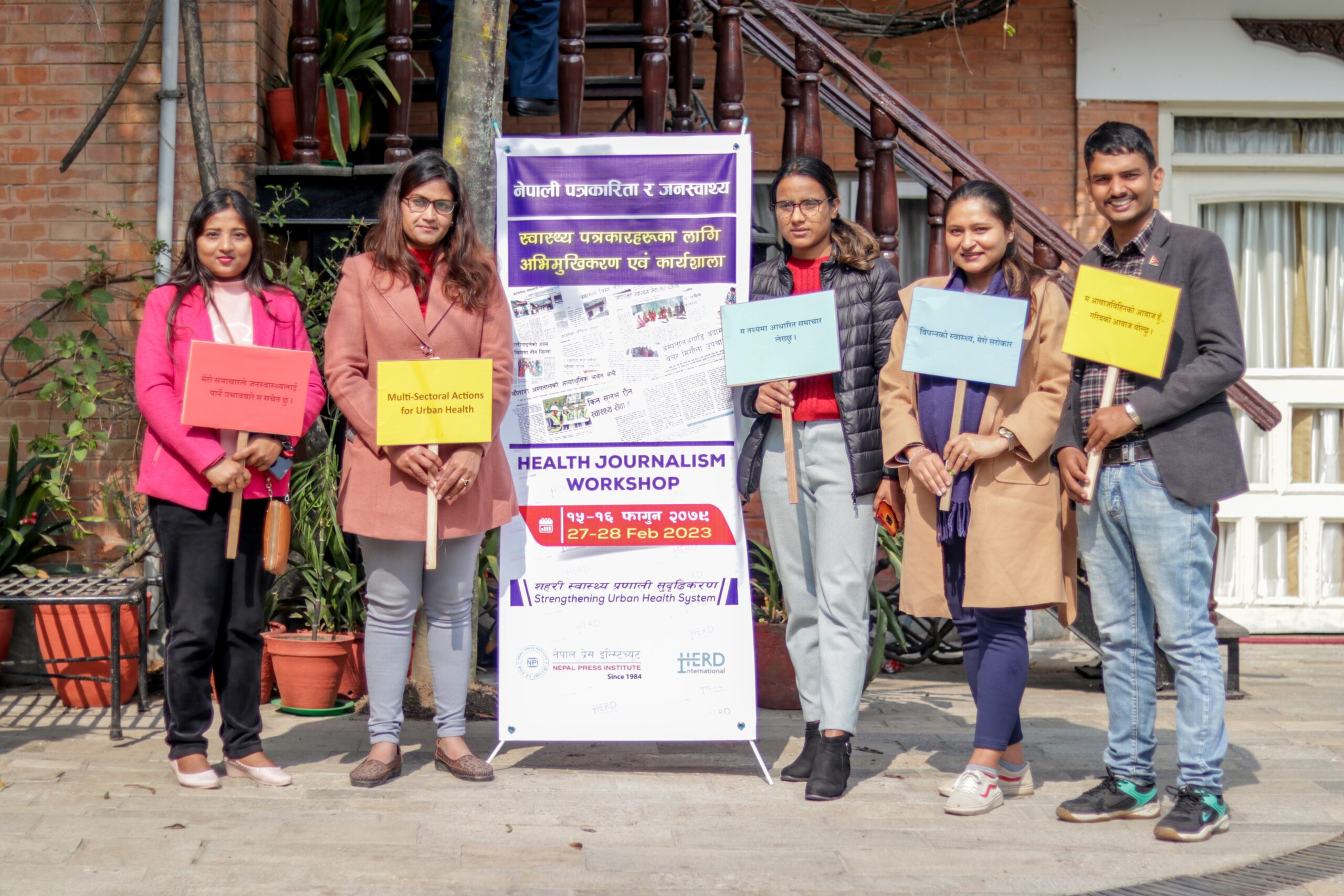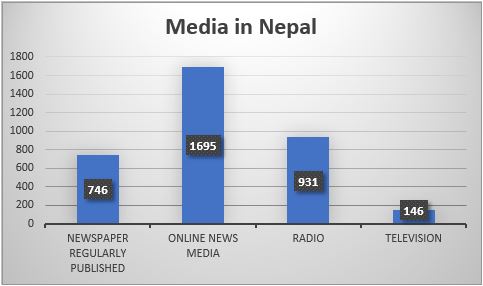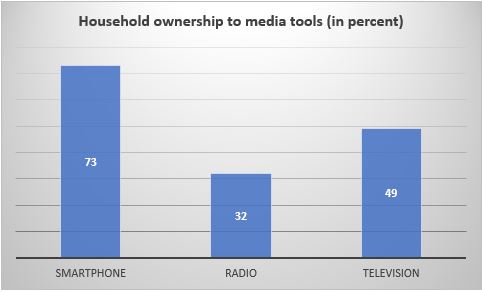
Blog: From People to Policy: Media has a lot to do in Health
“When a dog bites a man, that is not news, because it happens so often. But if a man bites a dog, that is news.”
This is a quote attributed to 19th century American journalist John B. Bogart. This quote is very commonly used in journalism teaching and journalistic practice while defining the news. This quote hints that any event or issue needs to be newsworthy to become news going beyond routine and the usual affairs. The news piece should capture the attention of the audience and provide valuable information. Probably this definition of news might be relevant in certain context but not always. “For me as a health journalist, this definition does not work at all. When a dog bites a man, this is news for me because stray dogs may transmit rabies to people leading to death, we cannot simply ignore it,” said Praveen Khanal, editor of a leading health news portal in Nepal while sharing his experiences about the challenges of health journalism during a two-day media workshop organized by HERD International and Nepal Press Institute in Kathmandu. Praveen is of a view that health journalism is not about trend setting, like sensational headlines of political affairs or corporate controversy, but protecting people and helping save their lives.
News media is an influential means to inform people and help construct their opinion about events happening in the world. Although concerns about media credibility have increased recently, when it comes to health, particularly in Nepal, journalism has a very prominent role in informing people and influencing policy actors. The media can provide a clear profile of heath agendas and bring policy issues to the public domain, helping people to be informed citizens. At this time, it is important not to simply report the events and diseases, but to take a deep, critical delve deep into the issues in a way that constructively supports efforts to achieve Universal Health Coverage (UHC). Given the high levels of health inequity and access to health services, this kind of detailed exploration of the issues is needed if we are to free people from financial hardship and ensure they receive quality health care. It is the state’s responsibility to ensure equitable quality health services, but the state alone cannot do everything without support from the stakeholders such as research institutions, non-government organisations and media. The role of media, as a fourth estate, is important as they are the main source of information for people and policy makers.
Health in Nepal’s media landscape
Nepal’s first newspaper Gorkhapatra was published in 1901. The restoration of democracy in 1990 paved the way for the private sector’s entry into broadcasting media legally and also promoted the scope of print media. As a result, there was a rapid growth of media including newspapers, radio and television. The record of the Department of Information and Technology shows 7,953 newspapers registered throughout the country. Although, there is no record of how many newspapers have been discontinued, a report of the Nepal Press Council states that 746 newspapers were under publication in 2020. Likewise, 1695 online news media, 186 television stations and 1931 radio stations have received licenses for operation. As the media industry grows in numbers, access to media is also growing in Nepal.
A recent census report published in 2021, shows that access to media has also significantly grown. According to the census report, household access to a smartphone is 73%, access to a radio is 32% and access to a television is 49%. Increasing media and people’s access to media provide ample grounds for quality use of information that can have a ‘positive impact’ on human life. Amidst an increasing number of media outlets, online news media dedicated to health is also growing in Nepal. Media educator and senior journalist Dhruba Hari Adhikari says that the quantitative growth of media is not enough, they must advocate for improvement on critical issues such as health and education of the people, especially, of marginalized populations and poor.
Source: (i) Department of Information and Technology, Nepal
ii) Nepal Press Council, Annual Report, 2020
Source: National Population and Housing Census, 2021
Health journalist experiences
To nurture and support health journalism in Nepal, to take advantage of the growing media space for health and the increasing number of journalists pursuing career in health journalism, HERD International has been engaging with the media to promote good practice in health reporting over the last few years, specifically in urban health. Conventionally, there is a perception that urban dwellers have better living standards and have easy health care access. However, important factors such as unsystematic urbanization, migration, presence of large number of poor populations in cities, ‘unhealthy’ lifestyle and air pollution among others have put urban people at risk. That’s why we felt the need to engage with the media to draw their attention towards urban health issues.
We have continued such engagements in our ongoing urban health system research, especially in providing technical support to health journalists. We recently conducted a workshop with health journalists working in national media and members of the health journalism association, in order to map the challenges of health journalists. The major challenges, according to the participants include, but are not limited to, lack of access to the resources in Nepali languages, limited ideas on the interpretation of information, andnewsroom pressure to produce news in limited time which affects journalists’ ability to investigate the issues in depth. In addition, there is a focus on reporting eye-catching events, whereas the critical issues such as air pollution, urban planning, people’s lifestyle and its contribution to non-communicable diseases, and issues that have long term health impacts, such as green spaces in cities, are not given significant priority.
Following this workshop, we organized a two-day health journalism training session for 20 journalists from major cities across the country, where they exchanged their experiences of health reporting. A common issue shared was that since they need to cover all beats with limited resources and time, health is not always a priority and they must produce ‘generic’ news instead of exploring in-depth stories. Health events, the status of the health services including infrastructure and human resources are the common issues they cover. The insights the journalists shared on the role of newsroom and editorial leadership in news prioritisation and determining the news angle, made us realise that we need to hold a meeting with the editors themselves to present the gaps in the country’s health system. This meeting allowed an exchange of ideas among the editors on how the media can address these gaps and report them differently, for example building stories as part of a thematic series. We were delighted when one editor of a national media said he wanted to hold a similar orientation for all the journalists working in his media organisation.
Need for collaborative engagement
Growth of news media and people’s access has offered a great opportunity to establish critical health agendas in Nepal where media can perform twin roles: raising awareness among people and supporting policy makers in policy decision process by accurately profiling the health issues. However, as journalists are not experts in health issues, their standalone efforts are not sufficient to produce credible news stories. Health organizations including research organizations, clinicians, public health experts need to collaborate with journalists and their associations for knowledge and skill enhancement of the journalists. In particular, collaborations are required to increase understanding of the complexities of health issues, access appropriate sources of information, synthesize the evidence and find the right angle of the news story.
With this realization, HERD International, in collaboration with Nepal Press Institute, started a dialogue with the media with the aim of sensitising journalists on health reporting, while focusing on the less explored areas of health system including urban health.
“I realized that we are more focused on health service and governance aspects of health in reporting, but the recent training made me feel that there are a lot of unexplored areas
in urban health such as disparities in access to service in urban area, air pollutions, burden of NCDs and more.” (training participant)
Watch here the video of the Health Journalist Workshop!
About the Author: Shreeman Sharma is the Global Research Uptake Lead for CHORUS, and is associated with HERD International.
Photo Credits: HERD International




